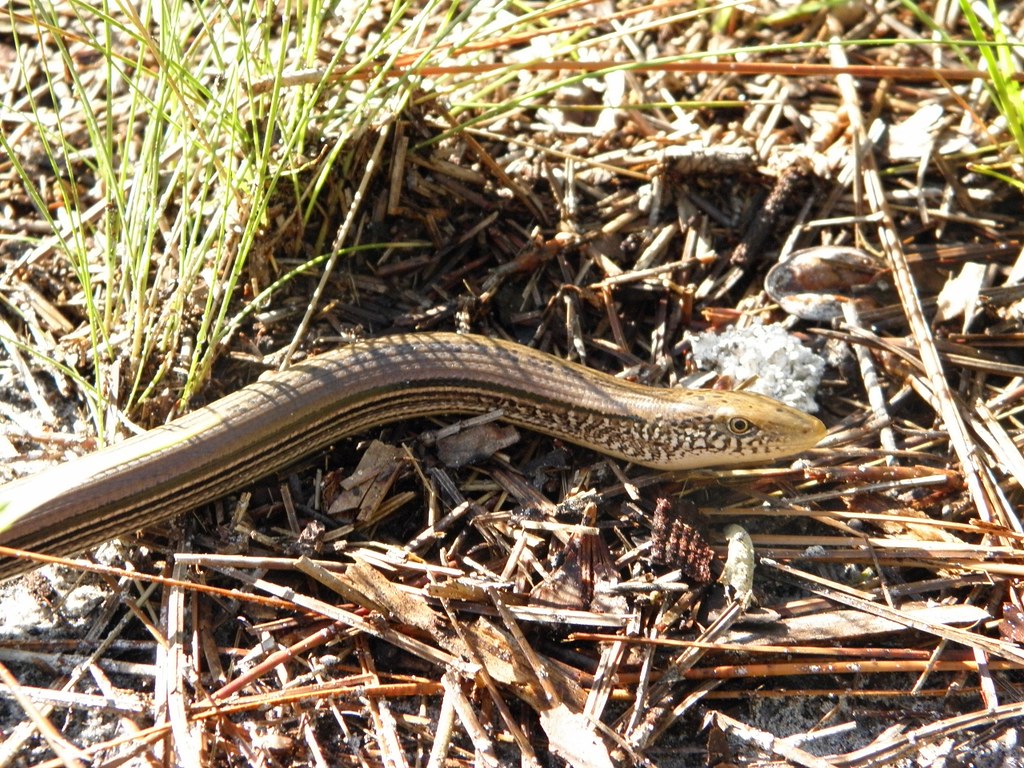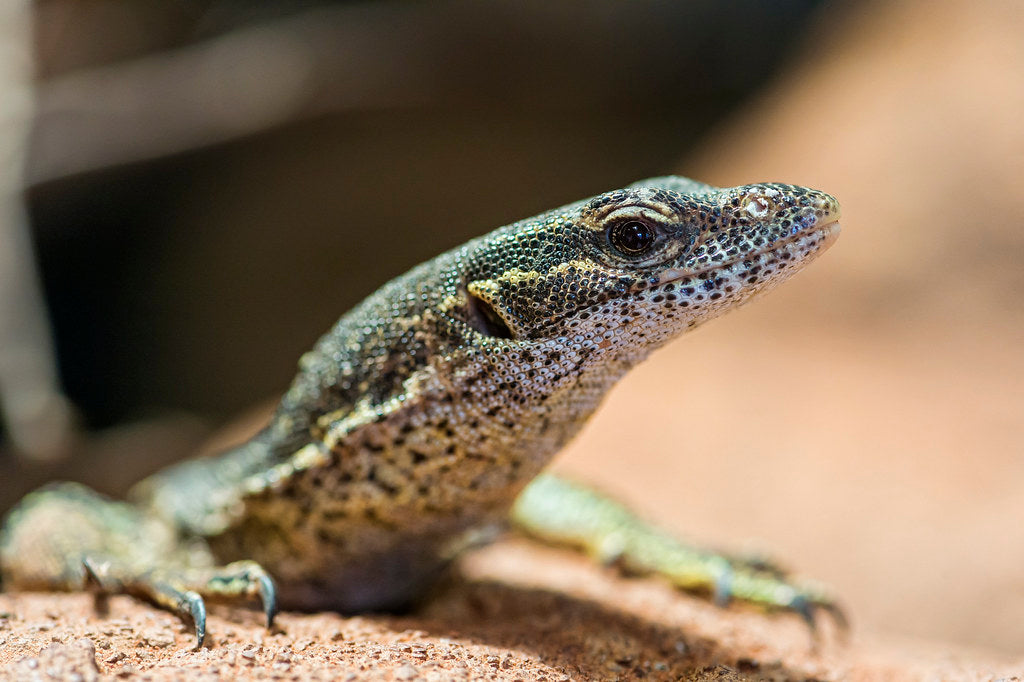Eastern glass lizards (Ophisaurus ventralis) are small to medium-sized, terrestrial reptiles native to the southeastern United States, including the Florida peninsula. They tend to prefer flatwoods, forests, meadows, marshes, and coastal dune habitats.
Eastern glass lizards can grow up to 3.5’ long, and their signature trait is their remarkably snake-like appearance due to their complete lack of limbs. However, what distinguishes them from snakes is the fact that they have eyelids, external ear openings, less flexible jaws, and a lateral groove. Also, most of their body is tail, rather than ribcage. Coloring is generally tan to brown on top with dark stripes or speckles, white stripes along the cheek and neck, and a yellowish underside.
Eastern glass lizards are intermediate-level pets due to the fact that not much is known about caring for them in captivity.
How much space do eastern glass lizards need?
Because eastern glass lizards are snakelike in appearance, many people think of them as smaller than they really are, keeping them in enclosures that are too small for them to stretch out fully and explore. This species is actually quite active! The minimum for appropriately keeping one adult eastern glass lizard is 48”L x 24”W x 24”H. This is just the minimum, so using larger dimensions is beneficial and will be happily used!
Cohabitation (keeping multiple eastern glass lizards in one enclosure) is not recommended.
Do eastern glass lizards need UVB?
Because eastern glass lizards’ husbandry requirements are not well known, it’s best to play things safe by providing an appropriate amount of high-quality UVB lighting. UVB gives reptiles all of the vitamin D that their bodies need, stimulates better appetite and activity, and generally allows them to be healthier than they would be without.
The best UVB bulbs for eastern glass lizards are:
The UVB bulb should be housed in a reflective fixture by Arcadia or Vivarium Electronics, and placed close to the heat lamp. This lamp should be about 9-11” above the basking area if over mesh, and 12-14” above the basking area if not. Also make sure that the fixture your UVB bulb is in does not have a clear plastic bulb cover, as glass and plastic block UVB wavelengths.
Lights should be on for 13 hours/day during summer and 11 hours/day during winter. This helps encourage more natural hormonal rhythms and better health.
What basking temperatures do eastern glass lizards need?
Like other reptiles, eastern glass lizards are ectotherms, which means that they need a temperature gradient in their enclosure to help them regulate their metabolism and stay healthy.
Eastern glass lizards should have a basking surface temperature of 90°F. On the other side of the enclosure, the temperature should be around 75°F. Surface temperatures can be measured with an infrared thermometer, but air temperatures should be measured with a digital probe thermometer.
Provide heat for your eastern glass lizard by imitating the sun with a halogen heat lamp placed on one side of the enclosure, positioned over a hide box with a flat stone on top. Do not use ceramic heat emitters (CHEs), red bulbs, or blue bulbs, as these are not as effective.
What humidity levels do eastern glass lizards need?
Eastern glass lizards need an average humidity of 65-75%, as measured by a digital probe hygrometer placed in the middle of the enclosure. There should also be a humid hide available for your pet, lined with moistened sphagnum moss.
Misting your lizard’s enclosure with a sprayer first thing in the morning and again at night will help create the right humidity levels. If you need more, moisten the substrate by mixing water into it as needed.
What substrate is good for eastern glass lizards?
Eastern glass lizards require a thick layer of moisture-retentive substrate to cushion their bodies, provide a burrowing medium, and help maintain healthy humidity levels. As an added perk, it also tends to make the enclosure more attractive!
Ideally, this substrate should resemble what eastern glass lizards naturally live on in the wild: sand or sandy soil. It should have small particles and hold moisture well. We recommend the following substrates for eastern glass lizards:
- Exo Terra Desert Sand
- Zoo Med Repti Sand
- Zoo Med ReptiSoil
Alternatively, you can mix clean topsoil and play sand together in a 60:40 ratio by volume. Either way, layering clean, chemical-free leaf litter on top of the substrate can help with humidity and provides additional enrichment value.
Substrate should be at least 4” deep and completely replaced every 3-4 months. Remove poop and urates daily, along with contaminated substrate.
What décor can you use in a eastern glass lizard terrarium?
It’s stressful for a reptile to be stuck in an enclosure with nothing in it except substrate and a water bowl. It doesn’t matter how big the enclosure is if you don’t put things in it for your pet to use and interact with.
At very least, you will need at least a couple of hiding places for your, as well as some live or artificial foliage to provide additional cover. However, it’s best to go beyond the minimum. Additional environmental enrichment options include:
What do eastern glass lizards eat?
Eastern glass lizards are insectivores, which means that they need to eat a diet of primarily insects in order to get the nutrition that their bodies need.
How often they need to eat depends on age. Juveniles should be fed daily, as much as they can eat. Adults can be fed 2-3x/week, depending on their body condition. Offer as many insects as they can eat in a 15-minute period. Each insect should be smaller than the lizard’s head.
Food options for eastern glass lizards: black soldier fly larvae, crickets, dubias, discoids, grasshoppers/locusts, snails (captive-bred only), mealworms, superworms, hornworms, silkworms, earthworms, darkling beetles, young mice
The key to providing a healthy, balanced diet for your pet is VARIETY, so make sure to rotate the feeders that you use.
Supplements
You will also need calcium and vitamin supplements to prevent your pet from developing a deficiency. We recommend Repashy Calcium Plus LoD, lightly dusted on all feeder insects.
Water
Of course, don’t forget a large water bowl for your lizard to drink from! Change the water daily and scrub the bowl with a reptile-safe disinfectant weekly, or whenever it becomes soiled.
Do eastern glass lizards like to be handled?
Few reptiles actually “like” to be held, and eastern glass lizards generally prefer to be left alone rather than handled on a regular basis. When startled, they will attempt to bite and may drop their tail.
If you absolutely need to pick up your eastern glass lizard, be gentle but firm, and pick up the animal from below rather than from above. Avoid chasing it around the enclosure. Support as much of its body as possible, and NEVER pick it up by its tail!
*This care sheet contains only very basic information. Although it’s a good introduction, please do further research with high-quality sources to obtain additional information on caring for this species.
"Ophisaurus ventralis; Eastern Glass Lizard" by Sharpj99 is licensed under CC BY-NC-SA 2.0




Leave a comment
This site is protected by hCaptcha and the hCaptcha Privacy Policy and Terms of Service apply.